
An impact event is a collision between astronomical objects causing measurable effects. Impact events have physical consequences and have been found to regularly occur in planetary systems, though the most frequent involve asteroids, comets or meteoroids and have minimal effect. When large objects impact terrestrial planets such as the Earth, there can be significant physical and biospheric consequences, though atmospheres mitigate many surface impacts through atmospheric entry. Impact craters and structures are dominant landforms on many of the Solar System's solid objects and present the strongest empirical evidence for their frequency and scale.
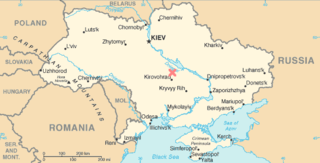
The Boltysh crater or Bovtyshka crater is a buried impact crater in the Kirovohrad Oblast of Ukraine, near the village of Bovtyshka. The crater is 24 kilometres (15 mi) in diameter and its age of 65.39 ± 0.14/0.16 million years, based on argon-argon dating techniques, less than 1 million years younger than Chicxulub crater in Mexico and the Cretaceous–Paleogene boundary. The Chicxulub impact is believed to have caused the mass extinction at the end of the Cretaceous period, which included the extinction of the non-avian dinosaurs. The Boltysh crater is currently thought to be unrelated to the Chicxulub impact, and to have not generated major global environmental effects.
Eagle Butte is an impact crater in Alberta, Canada, named for a rural area west of the Cypress Hills.
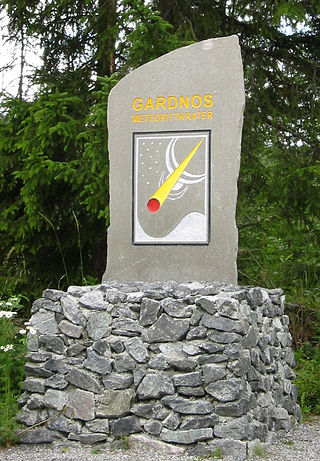
Gardnos crater is a meteorite impact crater in Nesbyen municipality in Viken county, Norway. It is located inside Meteorite Park (Meteorittparken) at Gardnos 10 kilometres (6.2 mi) north of the town of Nesbyen.
Mizarai is a meteorite impact crater in Druskininkai municipality, Lithuania. The crater is not exposed to the surface and the site now hosts Mizarai village. The crater is about 5 km (3.1 mi) in diameter and about 250 m (820 ft) in depth. It was created by an asteroid, estimated 300 m (980 ft) in diameter, 500 ± 20 or 570 ± 50 million years ago. The asteroid hit basement rock and shattered it up to 1.3 km (0.81 mi) deep. It was later buried under various sediments. Mizarai crater was discovered by Gediminas Motuza during an international seismic survey Eurobridge, which reached depths of 90–100 km (56–62 mi).
Obolon' crater Ukrainian: Оболонь is a 20 km (12 mi) diameter buried meteorite impact crater situated about 200 km (120 mi) southeast of Kyiv in Ukraine . The site has been drilled, which revealed the presence of shocked minerals and impact melt rock; the high chlorine content of the latter suggesting that the area was covered by shallow sea at the time of impact. One estimate puts the age at 169 ± 7 million years.
Steen River is an impact structure in Alberta, Canada. It is 25 km (16 mi) in diameter and the age is estimated to be 91 ± 7 million years. The crater is not exposed at the surface. The crater was partially eroded prior to burial, and lies under 200 m (660 ft) of sediments.
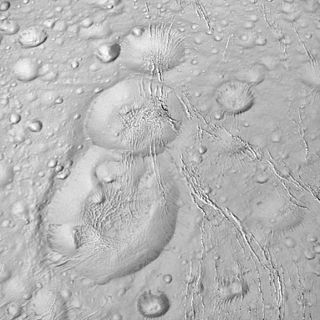
Dunyazad is a large crater on Saturn's moon Enceladus first discovered by the Voyager 2 spacecraft. It is named after Dunyazad, the sister of Scheherazade in The Book of One Thousand and One Nights.

Aram Chaos, centered at 2.6°N, 21.5°W, is a heavily eroded impact crater on Mars. It lies at the eastern end of the large canyon Valles Marineris and close to Ares Vallis. Various geological processes have reduced it to a circular area of chaotic terrain. Aram Chaos takes its name from Aram, one of the classical albedo features observed by Giovanni Schiaparelli, who named it after the Biblical land of Aram. Spectroscopic observation from orbit indicates the presence of the mineral hematite, likely a signature of a once aqueous environment.

Puńsk is an impact crater on Mars, located in the Oxia Palus quadrangle at 20.8° N and 41.2° W. It measures 11.6 kilometers in diameter and was named after the village of Puńsk in Poland.
Dhala crater is a crater formed by an asteroid impact. It is situated near Bhonti village in Pichhore block of Shivpuri district of Madhya Pradesh state in India. It is the largest crater in India, and between the Mediterranean and Southeast Asia. The diameter of the structure is estimated at 3 kilometres (1.9 mi), while other sources estimate its diameter to be 11 km diameter. It is the second such crater found in India, after Lonar lake.

Whitecourt crater is a meteorite impact crater in central Alberta, Canada, located approximately 10 km (6.2 mi) southeast of the Town of Whitecourt within Woodlands County. It is remarkable for being unusually well-preserved for a crater of small size and relatively young age.

McLaughlin Crater is an old crater in the Oxia Palus quadrangle of Mars, located at 21.9°N 337.63°E. It is 90.92 km (56.50 mi) in diameter and 2.2 km (1.4 mi) deep. The crater was named after Dean B. McLaughlin, an American astronomer (1901-1965). The Mars Reconnaissance Orbiter has found evidence that the water came from beneath the surface between 3.7 billion and 4 billion years ago and remained long enough to make carbonate-related clay minerals found in layers. McLaughlin Crater, one of the deepest craters on Mars, contains Mg-Fe clays and carbonates that probably formed in a groundwater-fed alkaline lake. This type of lake could have had a massive biosphere of microscopic organisms.
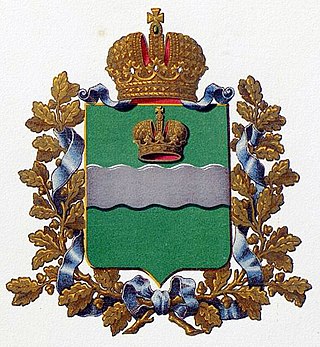
Kaluga Governorate (1796–1929) was a governorate of the Russian Empire and the Russian SFSR. Its capital was Kaluga.
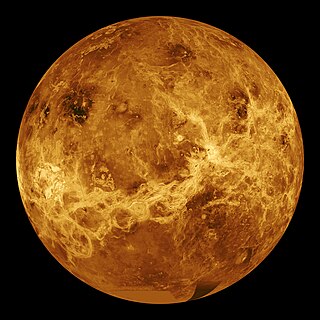
NASA's Magellan spacecraft mission discovered that Venus has a geologically young surface with a relatively uniform age of 500±200 Ma. The age of Venus was revealed by the observation of over 900 impact craters on the surface of the planet. These impact craters are nearly uniformly distributed over the surface of Venus and less than 10% have been modified by plains of volcanism or deformation. These observations indicate that a catastrophic resurfacing event took place on Venus around 500 Ma, and was followed by a dramatic decline in resurfacing rate. The radar images from the Magellan missions revealed that the terrestrial style of plate tectonics is not active on Venus and the surface appears to be immobile at the present time. Despite these surface observations, there are numerous surface features that indicate an actively convecting interior. The Soviet Venera landings revealed that the surface of Venus is essentially basaltic in composition based on geochemical measurements and morphology of volcanic flows. The surface of Venus is dominated by patterns of basaltic volcanism, and by compressional and extensional tectonic deformation, such as the highly deformed tesserae terrain and the pancake like volcano-tectonic features known as coronae. The planet's surface can be broadly characterized by its low lying plains, which cover about 80% of the surface, 'continental' plateaus and volcanic swells. There is also an abundance of small and large shield volcanoes distributed over the planet's surface. Based on its surface features, it appears that Venus is tectonically and convectively alive but has a lithosphere that is static.

Kaluga Turbine Plant is a company based in Kaluga, Russia and established in 1946. The Kaluga Turbine Plant Production Association produces turbines for naval ships and submarines. It also produces turbines for civilian power plants. It is located near the Kaluga Motor-Building Plant.
Vorotynsk is an urban-type settlement in Babyninsky District, Kaluga Oblast, Russia. Population: 10,667 (2021 Census); 11,288 (2010 Census); 11,099 (2002 Census);. The settlement hosts the former military airfield named Oreshkovo.
Kozlovo is a rural locality in Kaluga Urban Okrug, Kaluga Oblast, Russia. 13 (2010 Census);

In modern times, numerous impact events on Mars have been detected. Although most have been inferred from the appearance of new impact craters on the planet, some have corresponded to marsquakes felt by the InSight lander. To date, no impacting meteors have been directly observed as a fireball or discovered in space before impact.














